[NS23] Learning and Memory
Definition:
- Learning: acquisition of new knowledge or skills
- Memory: retention of learned informations
1. Types of memory and amnesia
- No single brain structure or cellular mechanism accounts for all learning
- The way in which information of a particular type is stored may change over time.
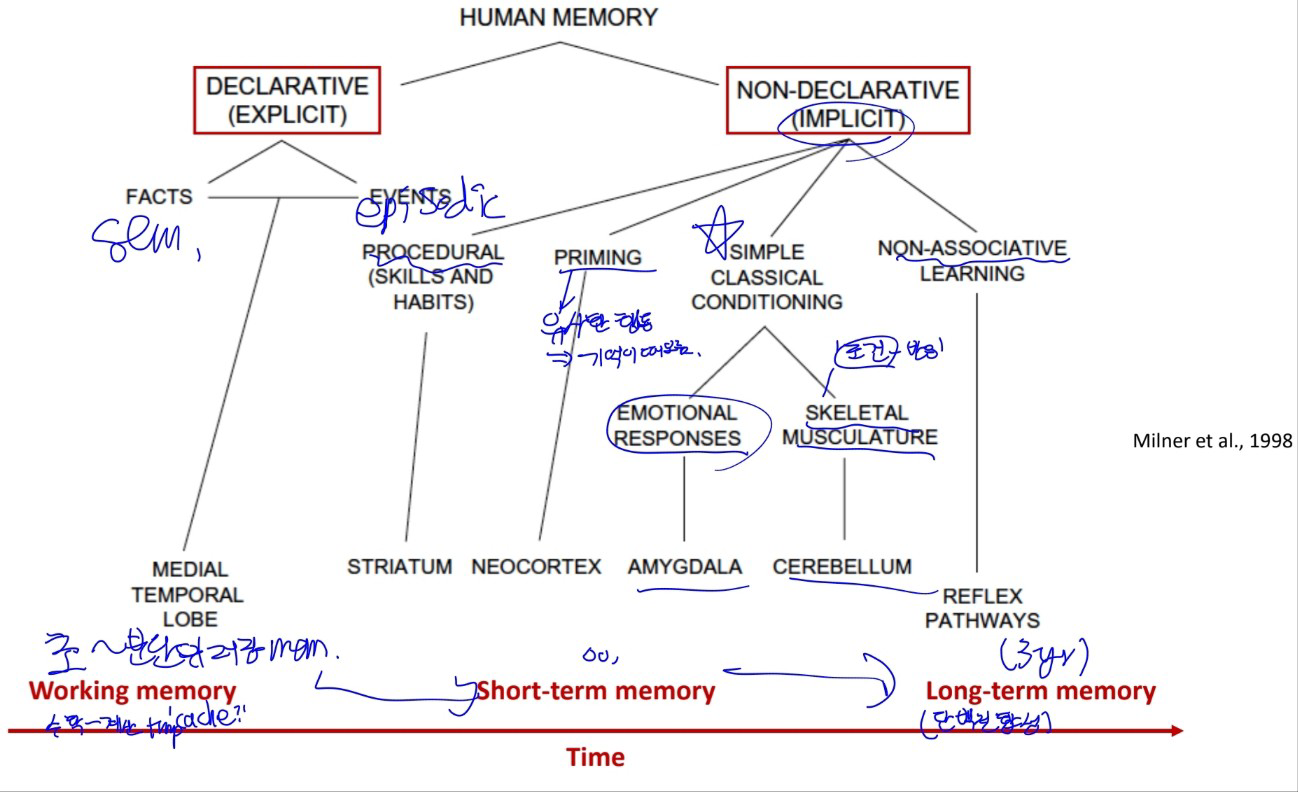
1.1. Declarative and Nondeclarative Memory

- Declarative Memory: Memory of facts (semantic memory) and events (episodic memory) (explicit memory: results from more conscious effort)
- Accessed for conscious recollection
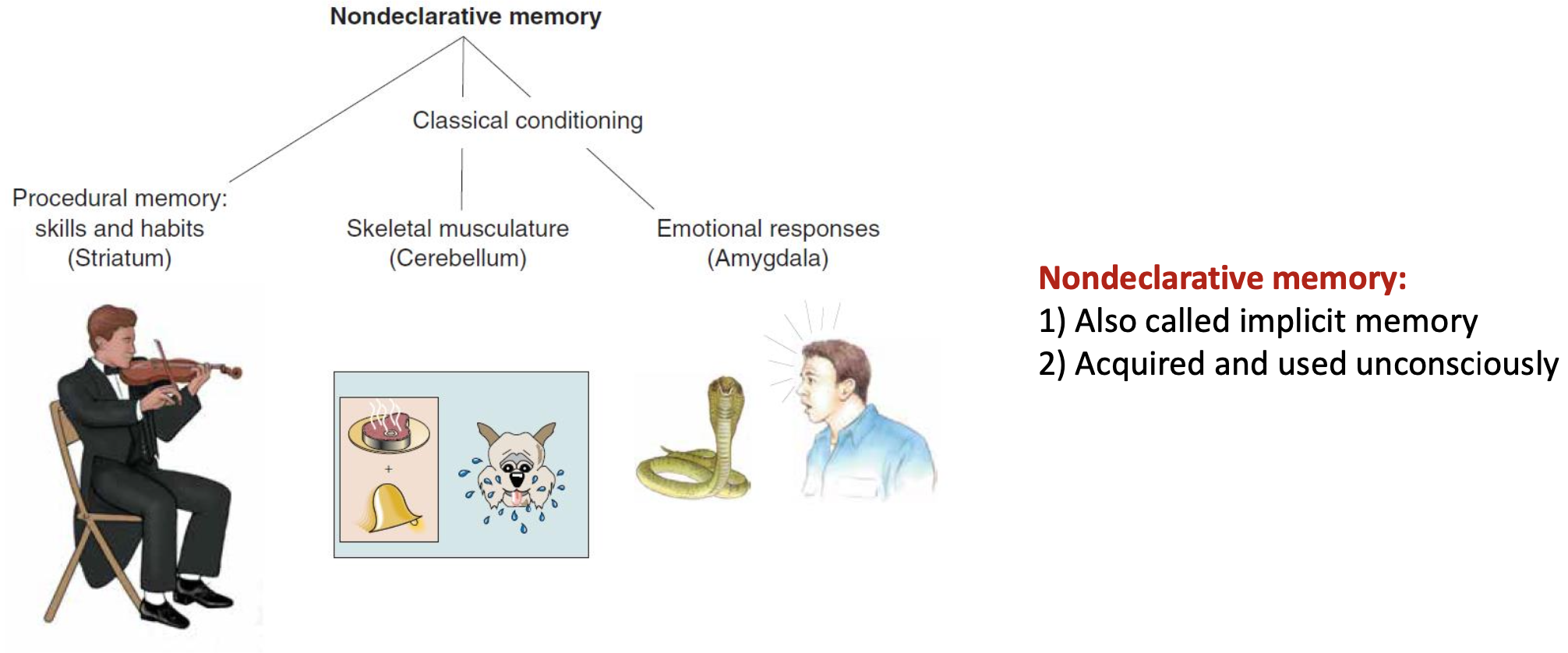
- Nondeclarative memories: Others (implicit memory: result from direct experience)
- Procedural memories: skills and habits (Striatum)
- Classical Conditioning:
- Skeletal musculature (Cerebellum)
- Emotional responses (amygdala)
1.2. Types of Procedural Memory
: Learning a motor response (procedure) in reaction to a sensory input
Formation (2): nonassociative learning and associative learning
1.2.1. Nonassociative Learning
Definition: A change in behavorial response that occurs over time in response to a single type of stimulus.
2가지:
1.2.1.1. Habituation: Learning to ignore a stimulus that lacks meaning.
- e.g. olfactory 등 반응이 둔화되는 것, 이거 공부하면서 밖에 차가 왔다갔다하거나, 동생이 자는 소리, 모기소리 등에 거의 반응하거나, 심지어 notice조차 안하는 것.
1.2.1.2. Sensitization (민감화): A form of learning that intensifies your response to all stimuli.
- e.g. 자라보고 놀란가슴 솥뚜껑 보고 놀란다, 횡단보도 건너다가 시야가 암전 => 다른 모든 감각이 활성화됨.

2 Graphs
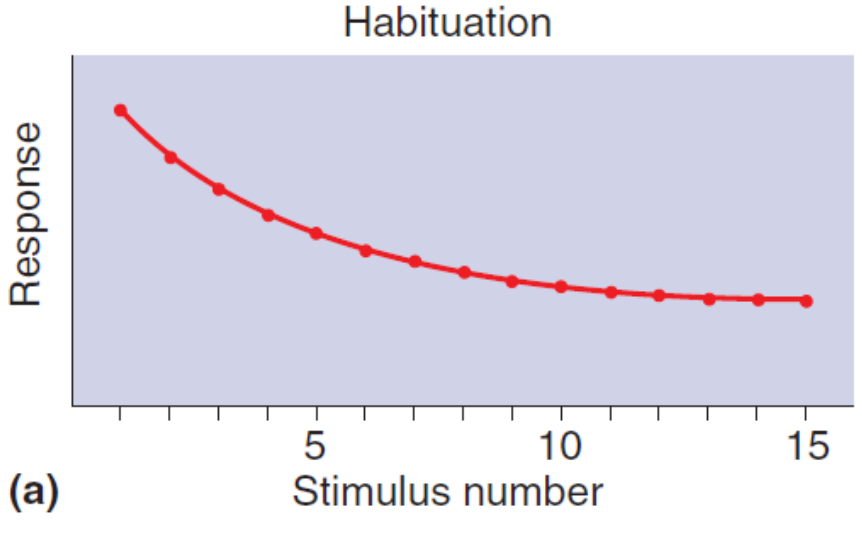 (repeated presentation of the same stimulus produces a progressively smaller response.)
(repeated presentation of the same stimulus produces a progressively smaller response.)
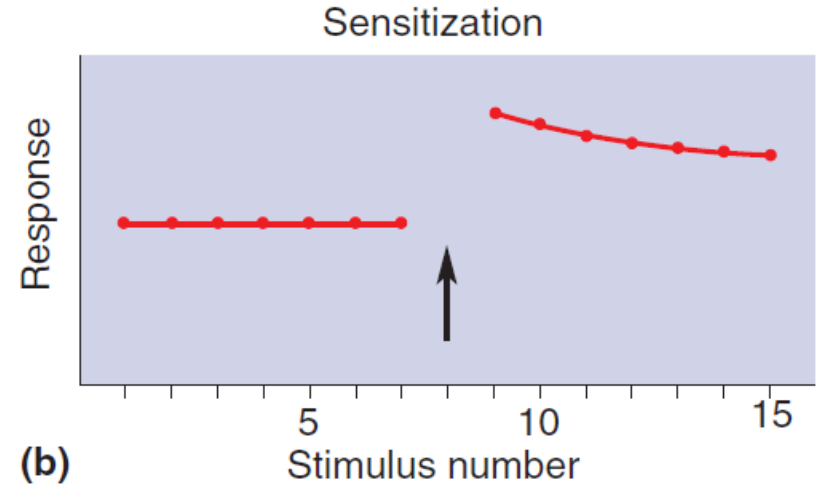 (a strong stimulus results in an exaggerated response to all subsequent stimuli.)
(a strong stimulus results in an exaggerated response to all subsequent stimuli.)
1.2.2. Associative Learning
Definition: Behavior is altered by the formation of associations between events.
1.2.2.1. Classical Conditioning
: Pairing/associating between distinct **stimuli**
e.g. Pavlov's dog experiment
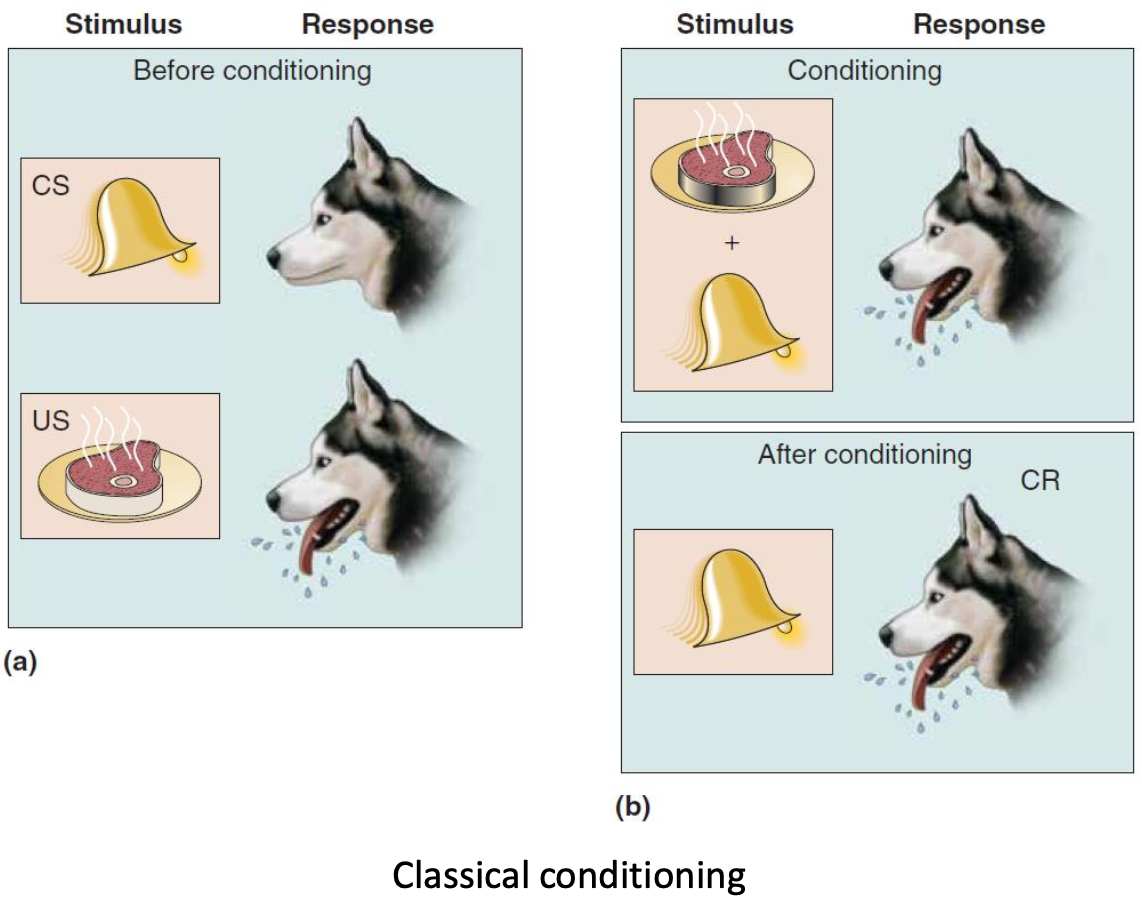
(a) Before conditioning, CS elicits no response, (b) Conditioning entails pairing the sound of the bell with the meat and after conditioning will salivate when the bell rings without the meat.
Terms
- US: Unconditional stimulus (본능상 response 일으키는 자극)
: The stimulus that normally evokes the response.
e.g. sight of a piece of meat => response: salivation
- CS: Conditional stimulus (neutral)
: The one that normally does not evoke this same response.
e.g. auditory stimulus e.g. sound of a bell.
After many (temporal) pairing of two stimulus, the dog had learned an association between the sound (CS) and the presentation of meat (US)
=> CS가 US의 특징을 획득함!!
CR: Conditioned Response; The learned response to the conditional stimuli.
cf. Temporal Arrangement of classical conditioning!

cf. CS를 통해 활성화되는 신경세포를 보고 CS 없이 그 뉴런만을 선택적으로 활성화 => UR 나옴. (반응성이 큰 세포의 AP만 선택적으로 막을 수 있음)
cf. Little Albert Experiment (불쌍한 알버트)
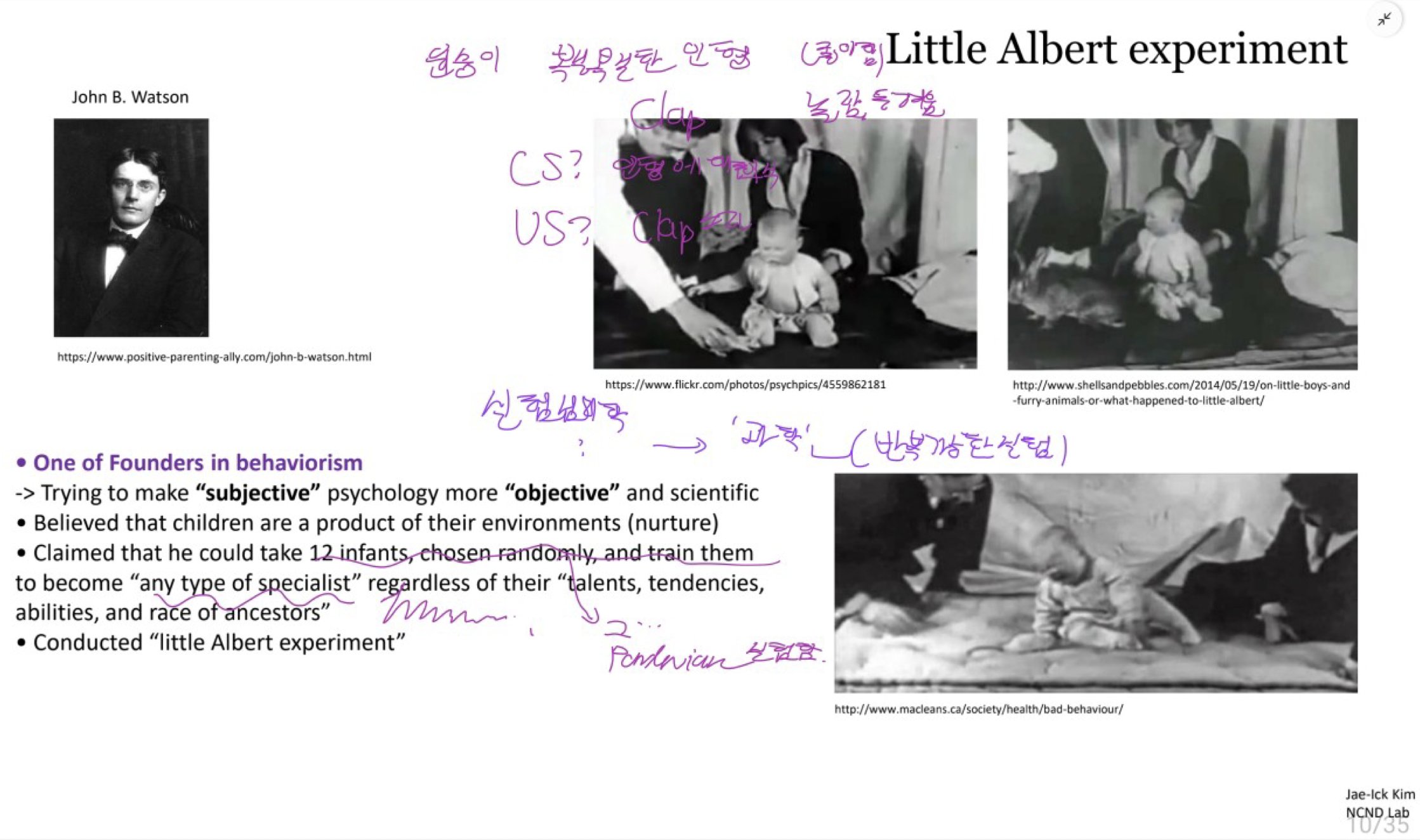
1.2.2.2. Instrumental conditioning
: Pairing between a response (behavior) and a stimulus (consequence, reward or punishment)
"i.e. reinforcement"

motivation plays such a large part in instrumental conditioning -> more complex neural circuits than simple classical conditioning.

1.3. Types of Declarative memory
Temporal categories

Long-term memories: 며칠, 몇 달, 몇 년동안 기억하는 것.
short-term memories: 몇 시간동안만 기억하는 것. vulnerable to disruption (e.g. head trauma, electroconvulsive therapy (ECT))
=> fact and events are stored in short-term memory and a subset are converted into long-term memories via memory consolidation.
working memory: temporary storage, like an L1 cache.
Even sharply limited in capacity and duration and require rehearsal. ‘in mind’ information
e.g. When someone tells you his or her phone number, retaining it for a limited period of time by repeating the number to yourself.
cf. capacity studied: measuring a person’s digit span; Maximum number of random numbers a person can repeat back after hearing a list read. (normal: 7+=-2라고 함.)
번호를 보는 것하고 기억하는 것이 기억 가능한 digit span이 다르다고 한다. This is consistent with the notion of multiple temporary storage areas in the brain.
1.4. Amnesia
: Serious loss of memory and/or the ability to learn
Possible causes: concussion (부딪히는 것. e.g. heading), chronic alcoholism, encephalitis (뇌수막염), brain tumor, and stroke (중풍; 뇌혈관막/터짐)
cf.
- absolute amnesia: limited memory problems associated with nonmemory deficts.
- disassociated amnesia: the memory problems disassociated from any other problems.
Following a trauma, two kinds:
- Retrograde Amnesia
- Anterograde Amnesia

Amnesias also appear in some movies.
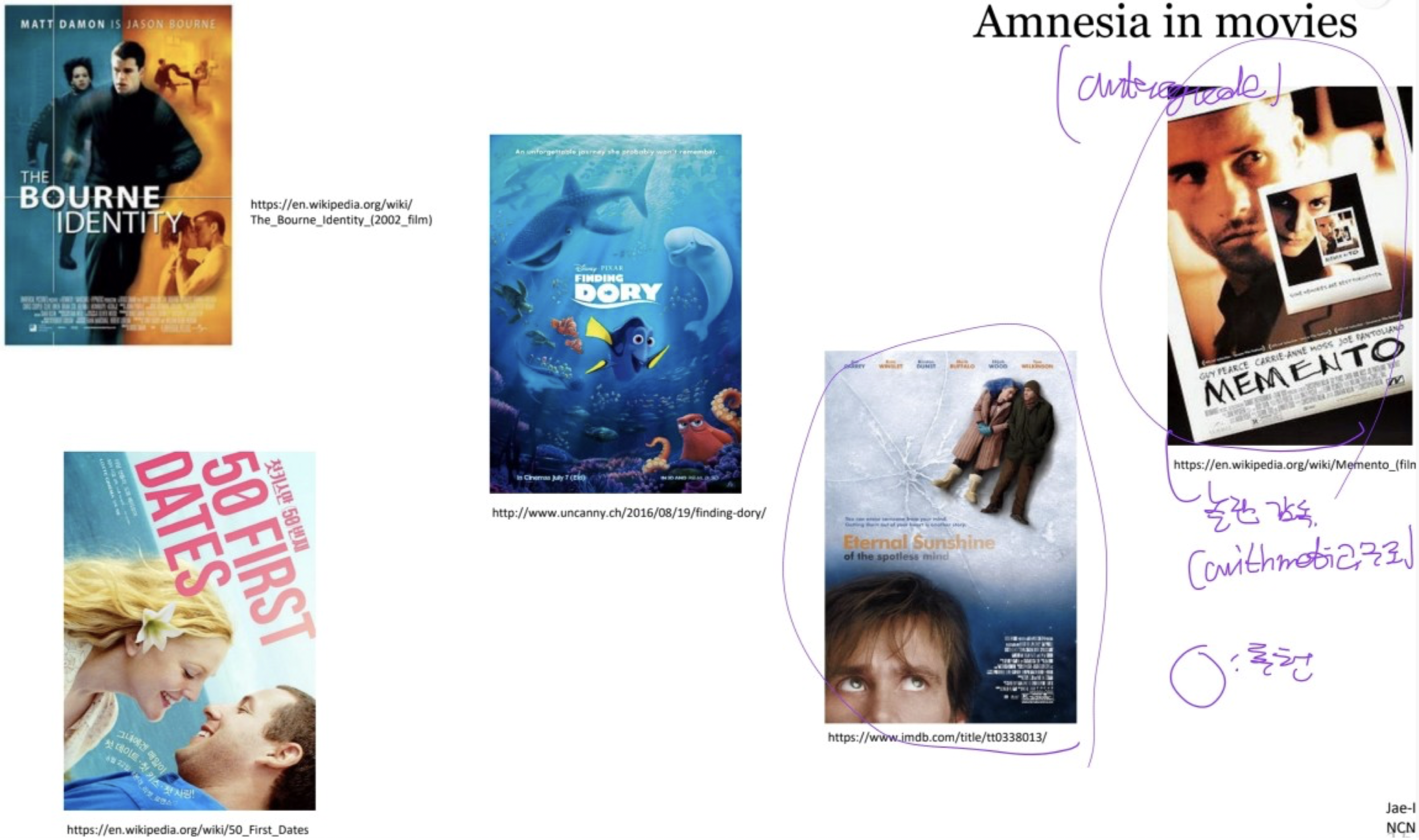
(skipped p.830 because of the test)
2. Working Memory
Working memory는 그 용량/정확성에 대해 tradeoff가 있다. 우리가 사실 숫자들을 chunks로 나누어서 생각하면 더 많은 숫자들을 기억할 수 있다고 한다.
대부분 필요없는 working memory는 discarded되지만, 일부는 brain에 충분히 긴 시간동안 저장된다. (converted into long-term memories)
어떻게 이런 일이 일어날까?
working memory는 neocortex의 capability라고 한다.
예를 들어서 frontal and parietal cortex를 좀 살펴보도록 하자.
2.1. The Prefrontal Cortex and Working Memory
Prefrontal cortex is implicated in working memory for problem solving and the planning of behavior.
Prefrontal cortical damage: deficts in some memory tasks.
e.g. in Wisconsin card-sorting test (p.16/35 or p.831-832)
- cue: (7secs)
- food placed into one of two wells within the monkey’s view.
- Delay (20secs)
- During the delay period, the animal cannot see the food wells;
- (눈을 특정 점에 초점을 맞추게 한다.) (눈의 방향으로 choose하지 않도록 하기 위함.)
- Choice Period: Choose a well.
동물이 처음 볼 때 vs 많이 보고 난 후.
prefrontal cortex activity는 well이 잘 안 보이는 delay period에서 훨씬 더 active한 것을 알 수 있다.
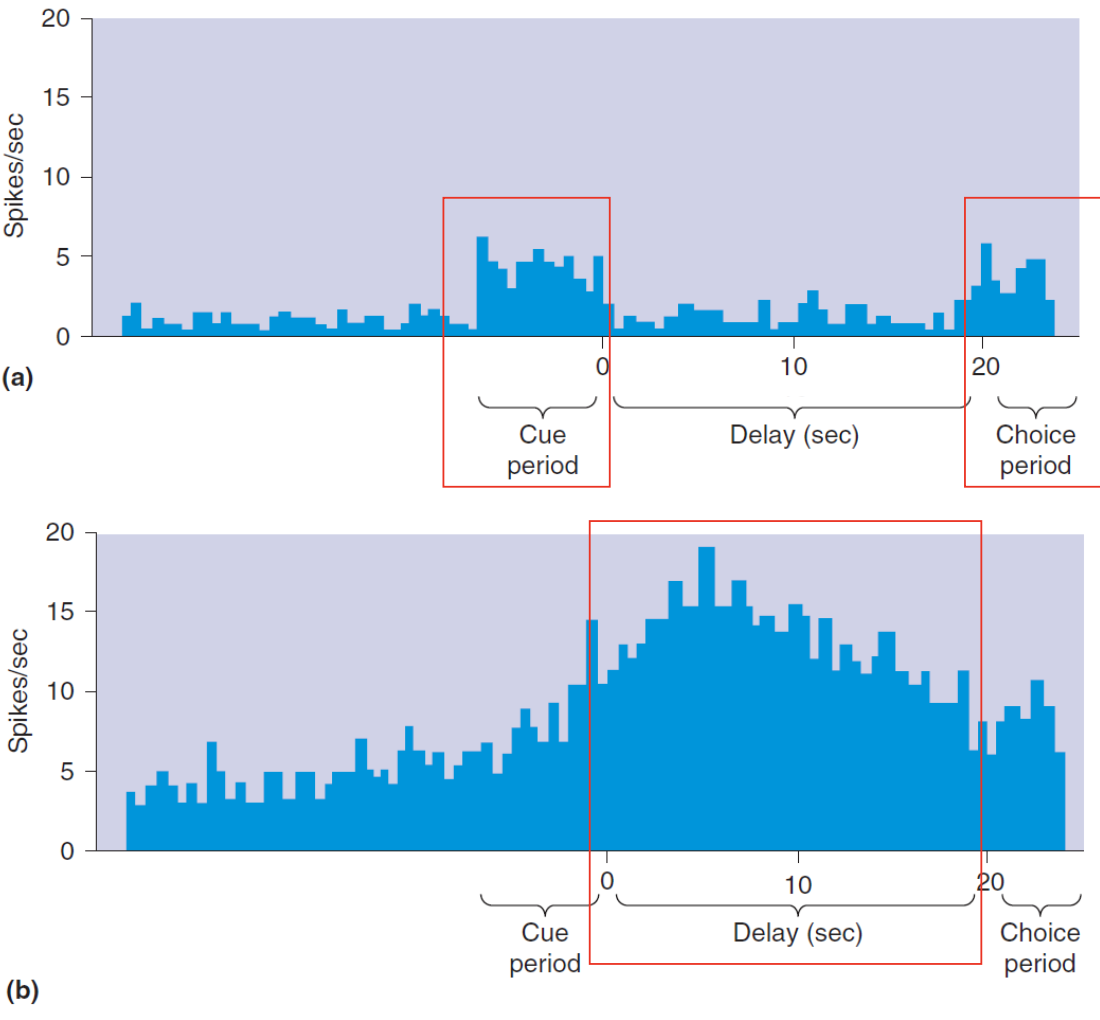
2.1.1. Image Working Memory in the Human Brain
Between memorization and test phases => brain activity in PET scan
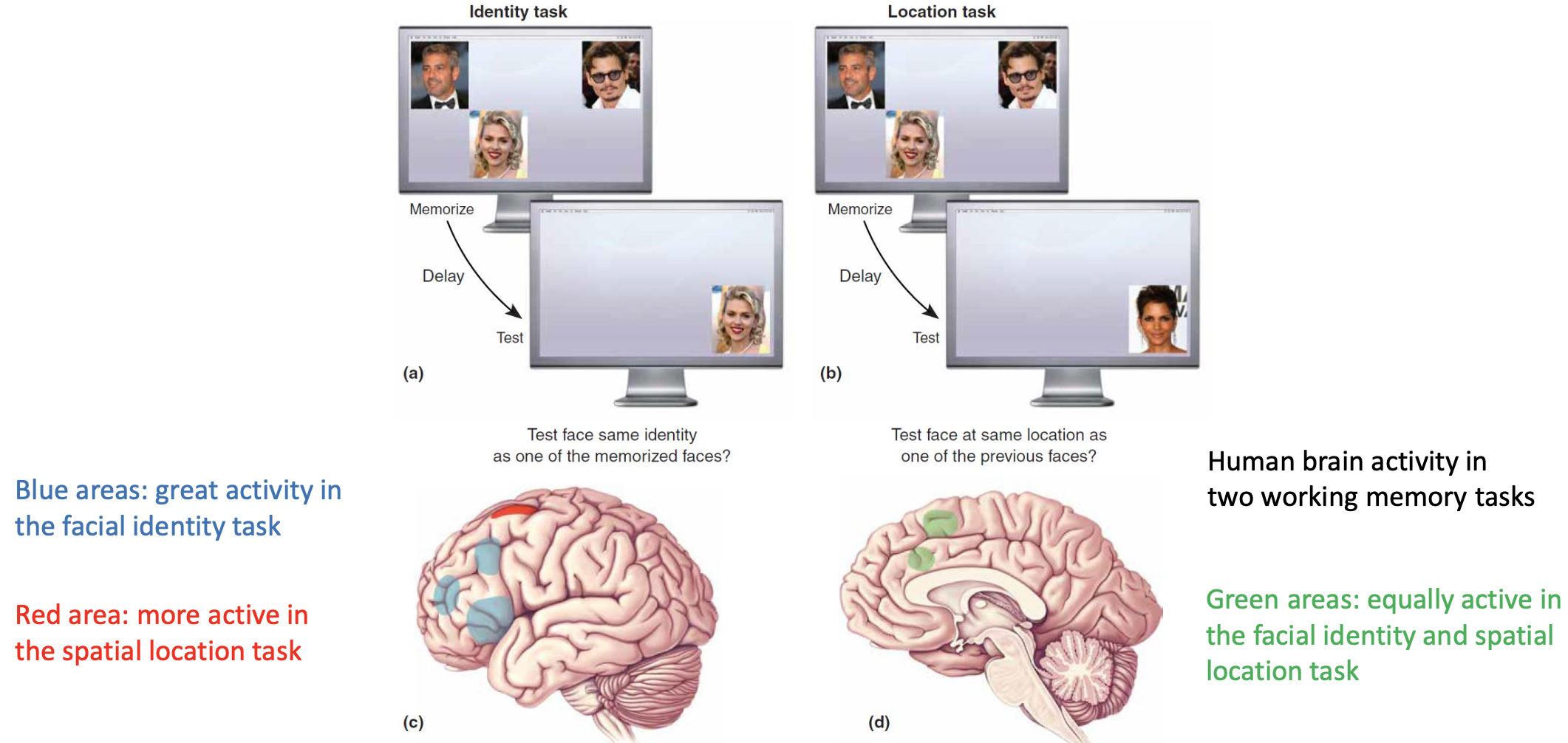
(a) (Facial)Identity task: Face => Is this the right face? (new location) (b) (Spatial)Location task: Face => Was a face here before? (a fourth face)
(a): Six areas in the frontal lobe (b): Other locations (): 교집합. e.g. cingulate gyrus
Unanswered question:
=> Working memory of other types of information is held in the same or different brain areas?
2.2. Area LIP and Working Memory
- LIP: Lateral Intraparietal Cortex (area LIP) (area 6)
-
thought to be involved in guiding eye movements (electrical stimulation here elicits saccades in monkeys)
saccade: 눈이 사물의 모습에 빠르게 초점을 맞추는 일.
증거? Monkey Experiment
- Given: At each of the steps, the monkey does these:
- Target on: The monkey fixates a central point while a peripheral target flashes on and off
- Delay: The monkey continues to fixate the central point (variable length)
- Saccade: Fixation point disappears, and the animal saccades to the remembered location of the target to earn a juice reward.
- Measure: LIP neruon activities in this experiment.
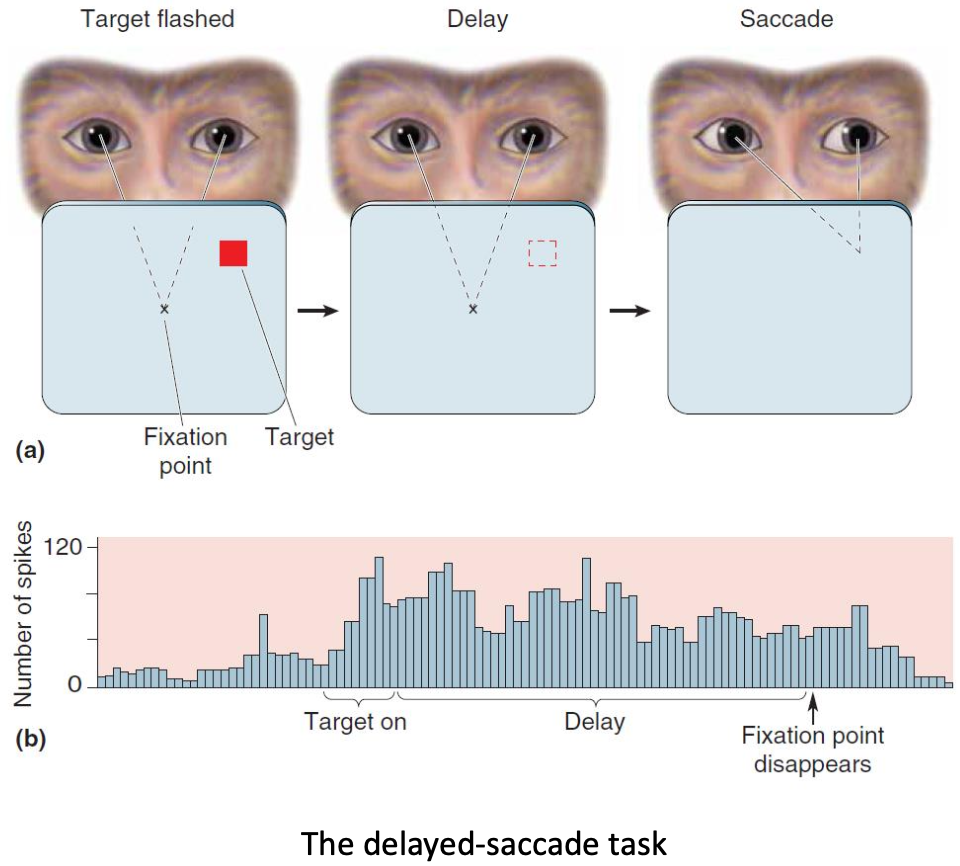
Result:
- Target on => The neuron begins firing.
- Delay: Cell keeps firing (where no stimulus is presented)
- Saccade: Stops firing.
Conclusion:
Response of the LIP neuron is temporarily holding information that will be used to produce the saccade.
other areas too .. just as the responses in area LIP are specific to vision.
Consistent with the clinical observation.
3. Declarative Memory
Engram (memory trace): where a memory is located/stored in the brain. (cf. coined by Richard Semon)
cf. 생명과학 인과관계 성립하는 3대 원칙
A => B
- Observational: A and B occurs
- Loss-of-Function: Not A => Not B?
- Gain-of-Function: In case of 2, Putting A make B happen?
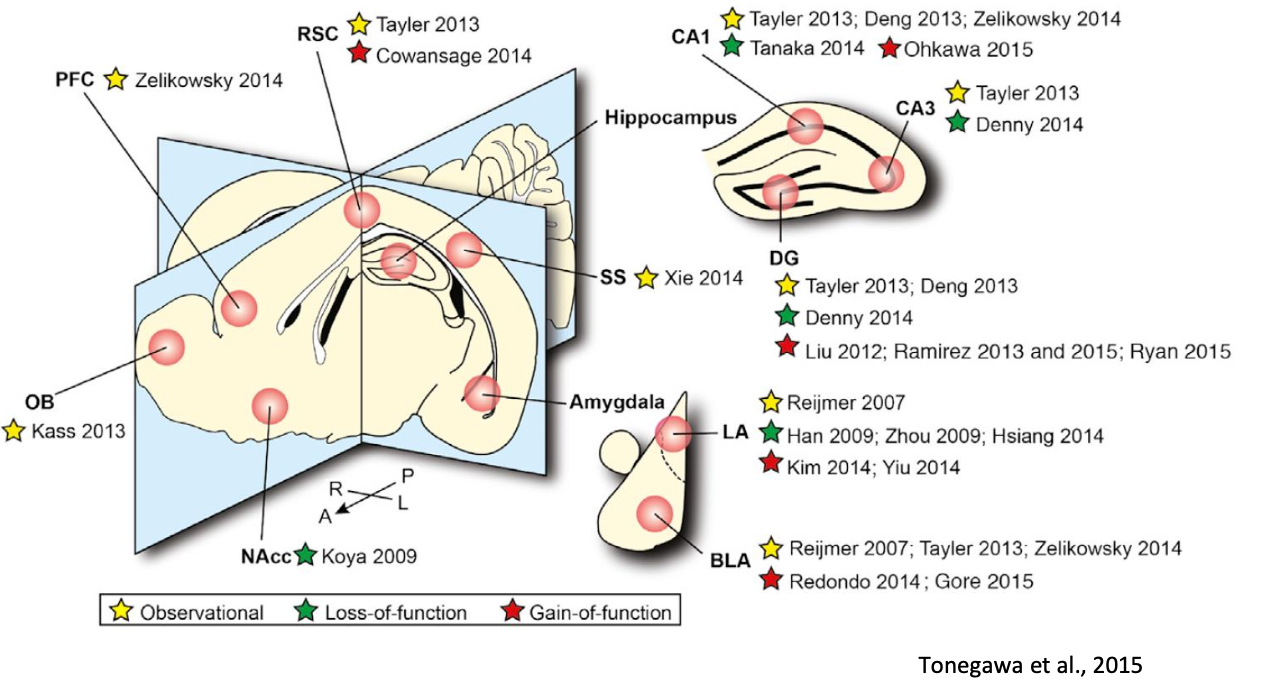
3.1. The Neocortex & Declarative Memory - Hebb and the Cell assembly
3.1.1. Lashley’s Experiment
Karl Lashley: Rat brain Lesion => Maze task (Is the engram located in the cerebral cortex?)
Thought: A single brain locus of engram? - disproving his own idea.
Lashley’s Conclusion (3)
- memories are not localized in one part of the brain; they are spread out through the cortex.
- Deficts caused by the lesions unrelated to the location of the lesion within the cortex.
- Equipotentiality: All cortical areas contribute equally to learning and memory
- Mass action; rate, efficacy (효능, 힘), and accuracy of learning depend on the amount of cortex available.
Problems in Lashley’s interpretation 1) Rats may have solved the maze in several different ways (the loss of one memory might have been compensated for by another) 1) e.g. 눈이 안 보이면 smell로 찾거나, smell이 안되면 머리 위 천장 형광등의 상대적 위치 등으로 찾거나. 2) Damaged brain areas were large.
Contribution to neural basis of memory storabe by Lashley.
- All cortical areas do not contribute equally to all memories
- All of the cortex participates in memory storage
- An engram (memory trace) can be widely distributed in the brain
3.1.2. Hebb and the Cell Assembly
Lashley’s most famous student; Donald Hebb. (Famous in DL.)
Hebb’s theory of cell assembly
- Internal representation of object consists of all the cortical cells that are activated by the external stimulus
- cell assembly: This group of simultaneously active neurons
“이거 잘 기억! 이것만이라도 잘 알기!”
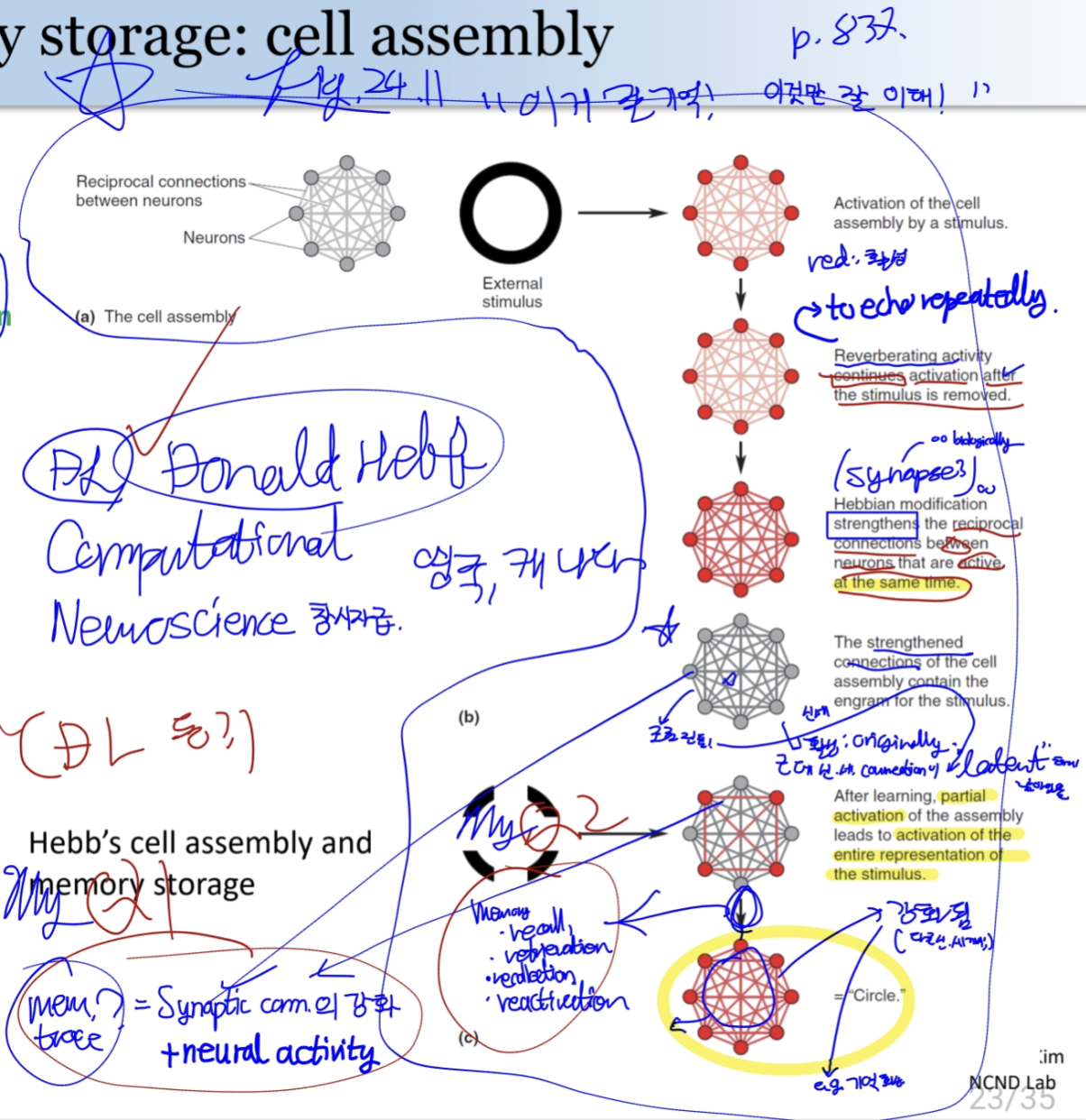
- The cells consisting a cell assembly are reciprocally interconnected.
- The internal representation of the object was held in working memory as long as activity reverberated through the connections of the cell assembly.
- If activation of the cell assembly persisted long enough, consolidation would occur by a “growth process” that made these reciprocal connections more effective; neurons that fired together would wire together.
- Subsequently, if only a fraction of the cells of the assembly were activated by a later stimulus, the now-powerful reciprocal connections would cause the whole assembly to become active again, thus recalling the entire internal representation of the external stimulus.
[N] memory trace? - The reinforcement of the synaptic connection. (+ neural activity?)
[N] The process by which a partial activation of the assembly leads to activation of the entire representation of the stimulus: : Memory… - recall - retrievation - recollection - reactivation.
3.2. Studies Implicating the Medial Temporal Lobes
Structures in the medial temporal lobe are involved in declarative memory formation.
3.2.1. Anatomy of the Medial Temporal Lobe
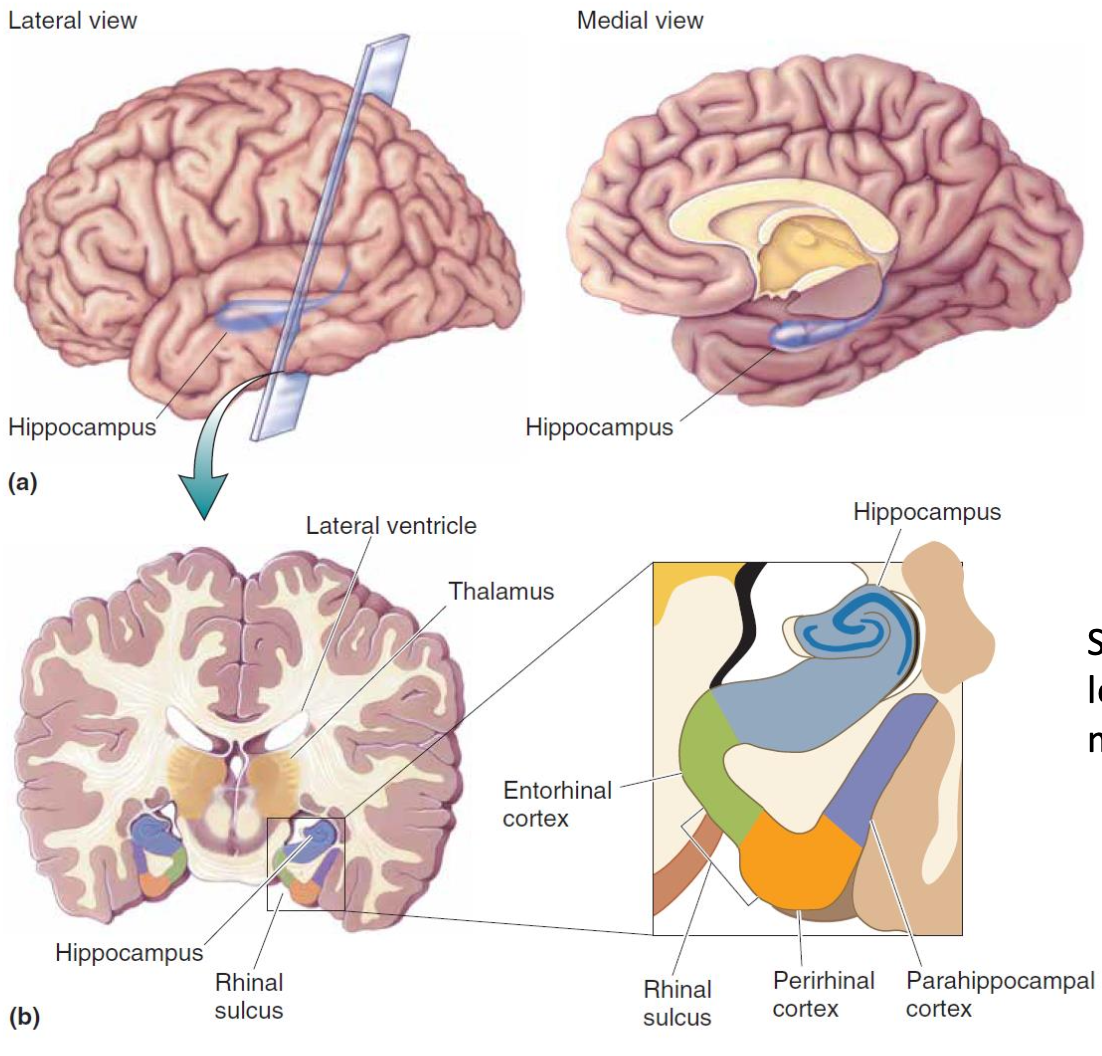
- key: hippocampus ~= seahorse

- Ventral to the hippocampus: 3 important cortical regions that surround the rhinal sulcus
- entorhinal cortex: Medial bank of the rhinal sulcus (occupies)
- perirhinal cortex: Lateral bank
- parahippocampal cortex: lateral to the rhinal sulcus.
[N] Let rhinal cortex referring to both the entorhinal and perirhinal cortex.
information flow through the medial temporal lobe is as follows:

- Major input: From the association areas of the cerebral cortex; containing highly processed information from all sensory modalities.
- Major output: the fornix, loops around the thalamus before terminating in the hypothalamus.
3.2.2. Electrical Stimulation of the Human Temporal Lobes ‘cf’
By Penfield.
Electrical Stimulation of the Human Temporal Lobes: caused more complex sensations : Consistent with reports; epileptic seizures of the temporal lobes can evoke complex sensations, behaviors, and memories
Reexperiencing events from earlier in their life?
No way to prove that the sensations are recalled memories.
However, it is clear that the consequences of temporal lobe stimulation and temporal lobe seizures can be qualitatively different from stimulation of other areas of the neocortex.
3.2.3. Neural Recordings from the Human Medial Temporal lobe

A patient’s hippocampal neuron selectively responds to actress Halle Berry
Berry Cell? Bred Pete cell?
3.3. Temporal Lobe Amnesia
3.3.1. The Case of H.M.: Temporal Lobectomy and Amnesia
H.M.: Henry Molaison (dead in 2008); probably the most famous initials in the history of neuroscience.
- Experienced minor epileptic seizures beginning around age 10, and as he aged, became a serious generalized seizures involving convulsions, toungue biting, and loss of consciousness.
- As anticonvulsants didn’t work and the seizures increased in frequency and severity
- Had an operation of temporal lobectomy => successful in alleviating the seizures.
- No affect of perception, intelligence, or personality, but profound and debilitating (causing serious impairment of strength or ability to function) anterograde amnesia. (number ~ => working memory만 존재함… 와… 불쌍해…)

3.3.2. An Animal Model of Human Amnesia
skip.
3.4. Memory Functions of the Hippocampal System
Medial temporal lobe :: imp for declarative memory.
Well, first keep a few basic points in mind to avoid getting lost.
- The hippocampus appears to play a critical role in binding sensory information for the purpose of memory consolidation
- A lot of research, particularly in rodents, has shown that the hippocammpus supports spatial memory of the location of objects of behavioral importance.
- The hippocampus is involved in the storage of memories for some length of time, though the time duration is controversial.
3.4.1. The Effects of Hippocampal Lesions in Rats
Radial Arm maze
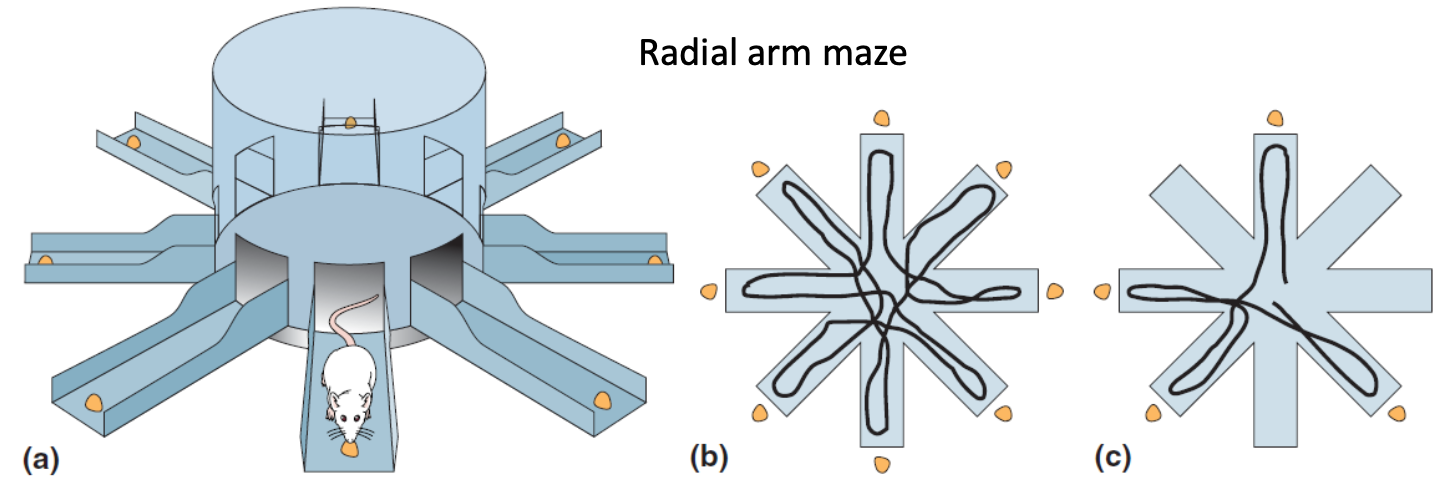
- Normal rat:
- explore until it finds the food at the end of each arm.
- After practice, become efficient at finding all the food.
- Without going twice into any of the arms
- Visual cues, etc.
- Working memory is presumably used to retain information about which arms have been visited.
- Learns to avoid going down the arms that never contain food.
- Hippocampus-destroyed-rat:
- They learn to go down and eat the food placed at the end of each arm. (the procedural memory)
- DO Learns to avoid going down the arms that never contain food.
- They never learn to do this efficiently.
- Go down the same arms more than once, leaving other arms containing food unexplored for an abnormally long time.
- They cannot seem to remember which arms they have already visited.
Interpretation:
- existence of no-food arms: procedural memory
- which arms already entered: working memory
3.4.2. Spatial Memory, Place Cells, and Grid Cells
3.4.2.1. Morris water maze

-
Rat이 물 속에 들어가요. Submerged just below the surface in one location is a small platform that allows the rat to escape the water.
일반 쥐돌이:
- Swim around until bumps into the hidden platform.
- Quickly learn the spatial location of the platform. => swim straight to it, wasting no time.
- Put in a maze with the platform at a different location: learn the task much faster.
Bilateral hippocampal damaged 쥐돌이: Never seem to figure out the game or remember the location of the platform.
Hippocampus is particularly important for spatial memory.
(Lesion or dysfunction in hippocampus impair spatial memory)
3.4.2.2. Place Cells
Place cells in the hippocampus
Place cell: A neuron in the rat hippocampus that responds only when the animal is in a certain region of space.
Activated when 특정 위치, 공간, 장소, 사물 감지가 특정됨.
Place cell은 exploring the box 이후 조금 있다가 (10 minutes 다음에) 형성됨
형성 이후, 쥐가 상자의 특정 위치에 있을 때 특정 place cell이 활성화된다.
다른 공간에 갈 때 => all reset; firing 위치가 달라진다.
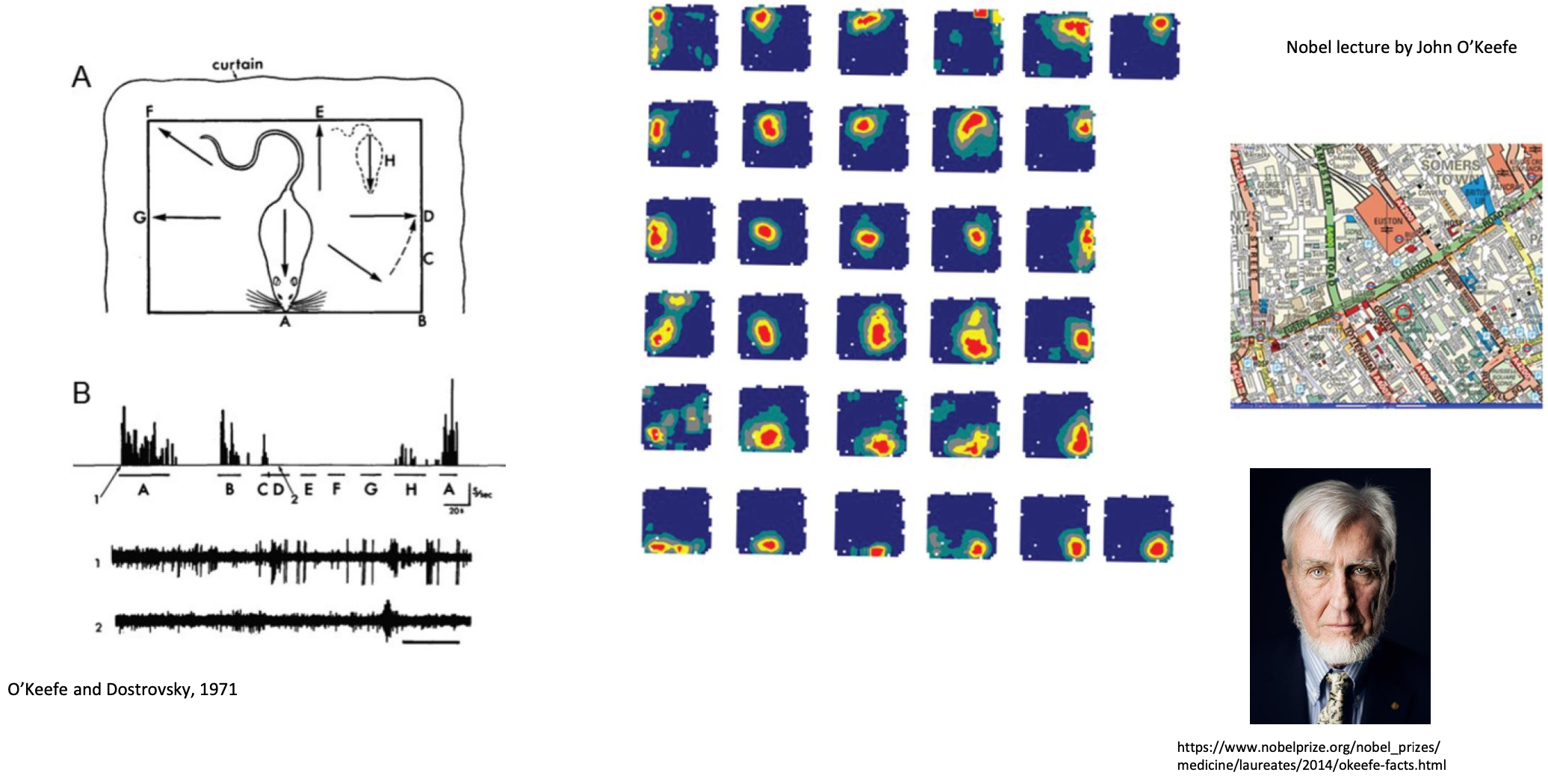
3.4.2.3. Grid Cells
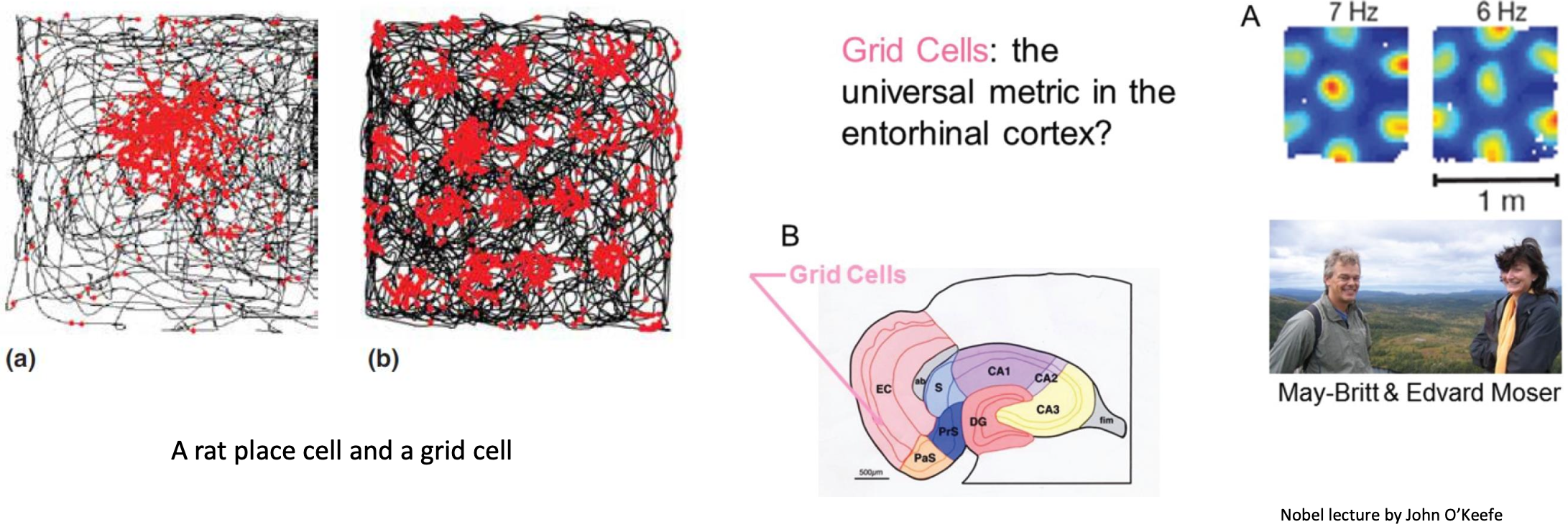
(a): Place Cell, (b): Grid Cell (hexagonal grid, like a honeycomb)
Black: moving path of a rat in a box Red spots: locations of the rat associated with neuronal activity.
즉, 신경세포 하나가 firing되는 rat의 위치.
Grid 간격 hcange => 물리적 거리, 위치관계, resolution 을 담는다.
3.4.3. Hippocampal Functions Beyond Spatial Memory: in cognition
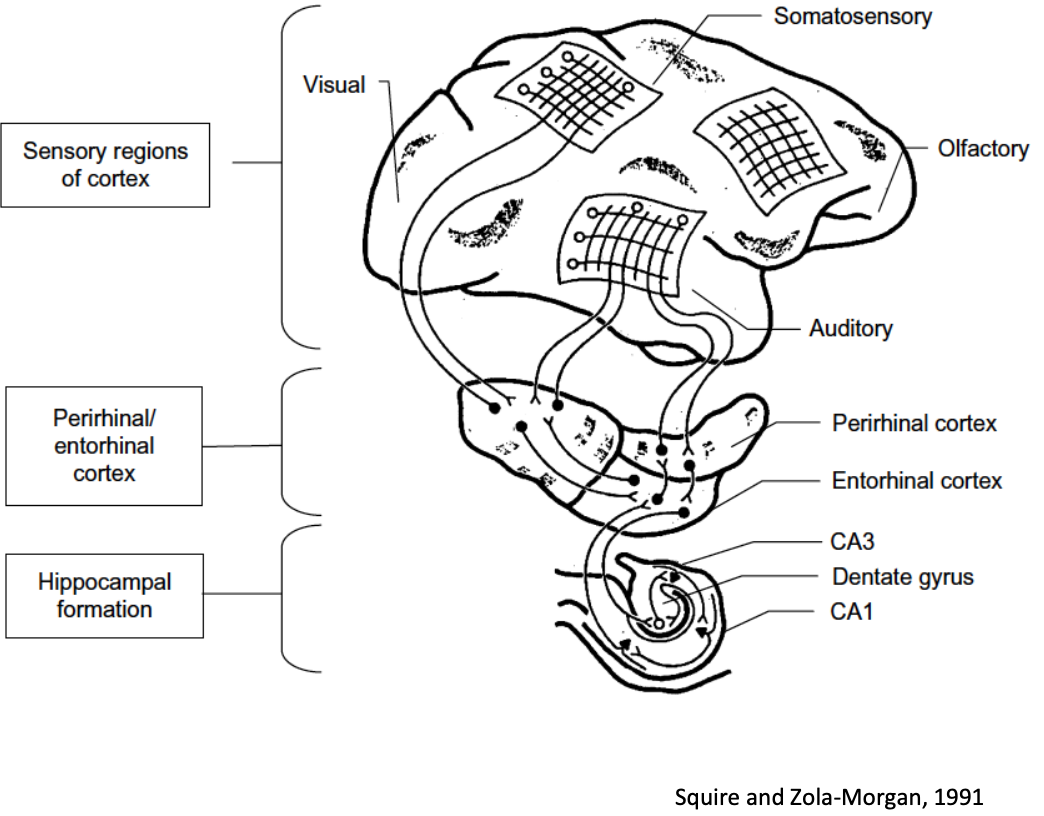
- Spatial Information (space) (although not 3D. (교수님이 그래서 3D maze를 졸업하면서 연구해보겠다고 대학원생때 했다고 한다.))
- Temporal Information (time)
- Multimodal associations
- Generalized association machine and multimodal sensory integrator (e.g. 한우 -> 온도, 향, 맛, 색깔) (물리->감정, 사람들 기억 ㅇㅇ => 자아)
- Memory consolidation (short-term -> long-term memory)
- Serving as a short-term memory store that untimately downloads information to the cortex for long-term storage.
3.5 Consolidating memories and Retaining Engrams
Questions:
- When and where are the memories stored in a permanent form?
- How long does it take memories to become “permanent?”
- Do engrams change location over time?
- Can subsequent experiences alter, enhance, or degrade memories?
3.5.1. Standard and Multiple Trace Models of Consolidation
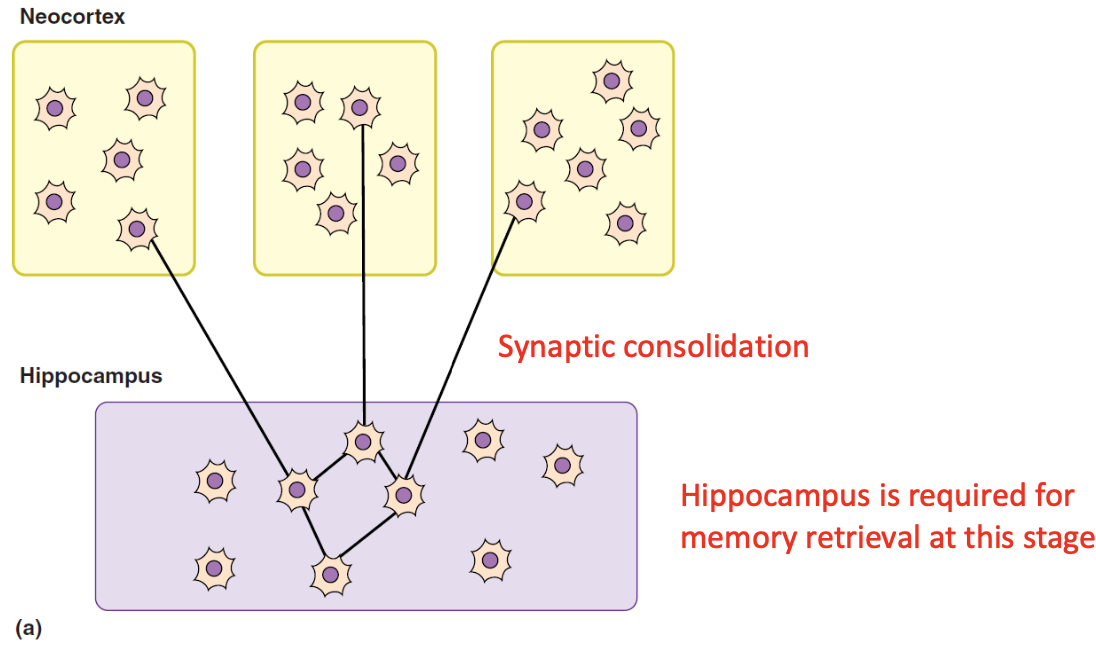
As in the above Figure, memory formation is initiated by synaptic changes in the hippocampus by the sensory inputs from the neocortex.
How is it formated? Well, here’s how it goes.
It divides into twe stages;
- Long-term Memory Formation
- Remote Memory Formation (‘초장기기억’)
Let’s take a look how it goes.
3.5.1.1. Long-term Memory formation (Last for 1-3 days)
- Some neurons of the neocortex (e.g., visual cortex, sensory cortex) send information to the Hippocampal neurons. [Neocortex -> Hippocampus.]
Let, for instance, i1 and i2 denote some neurons in the neocortex that sends information to the Hippocampal neurons o1, and o2, respectively.
- Synaptic Consolidation (~’Learning’); a process via which the changes in synapses create a memory trace.
- In this example, the next chance that the activation of i1 and i2 triggers the firing of o1 and o2 neurons increases, respectively.
- Also, o1 and o2 themselves become more likely to trigger mutual activation.
- The hippocampus is required for memory retrieval at this stage.
If you blow up the hippocampus in this stage, you cannot retrieve your memory.
Note that we saw this kind of figure when discussing the REM sleep.
3.5.1.2. Remote Memory Consolidation
Now, let’s take a look at the process of ‘Remote memory (for several~tens of years) consolidation’ (systems consolidation) that happenes during, or after the synaptic consolidation.
There are two alternative? theories explaining this kinda thing;
- Standard model of memory consolidation
이건 기억이 다 neocortex로 넘어가서 그 자체만으로 engram을 형성한다는 이야기이다.
그러면 해마를 거치치 않고, 그리고 해마 없이도, neocortex의 firing만으로 기억을 회상할 수 있겠지.
Here’s how it goes.
기억이 다 neocortex로 넘어가 있다. Engrams are moved gradually over time into distributed areas of the neocortex.
이 과정이 끝난 다음에는 retrieval시 Hippocampus가 필요 없다.
그런데, 저번에 본 H.M.이라는 환자의 case study는 이 결과와 부합하지 않는다; 그 환자는 anterograde뿐 아니라 retrograde로도 기억이 사라졌다고 한다.
그래서 이걸 설명할 수 있는 또 다른 이론이 있지.
- Multiple trace model of consolidation
이는 뭐냐하면, 대충 hippocampus는 항상 memory storage에 관여한다는 것이다.
- engram은 overlap 가능.
e.g. o1과 o2를 포함하는 서로 다른 두 engram이 hippocampus와 neocortex를 포함하며, 그 둘은 겹칠 수 있다.
- 아무리 remote memory라 해도, 해마에서의 engram도 retrieval에 필요하다.
i.e. Each time an episodic memory is retrieved,
- The retrieval occurs in a context different from the initial experience.
- The recalled information combines with new sensory input to form a new memory trace involving both the hippocampus and the neocortex.
대충 그런 얘기다.
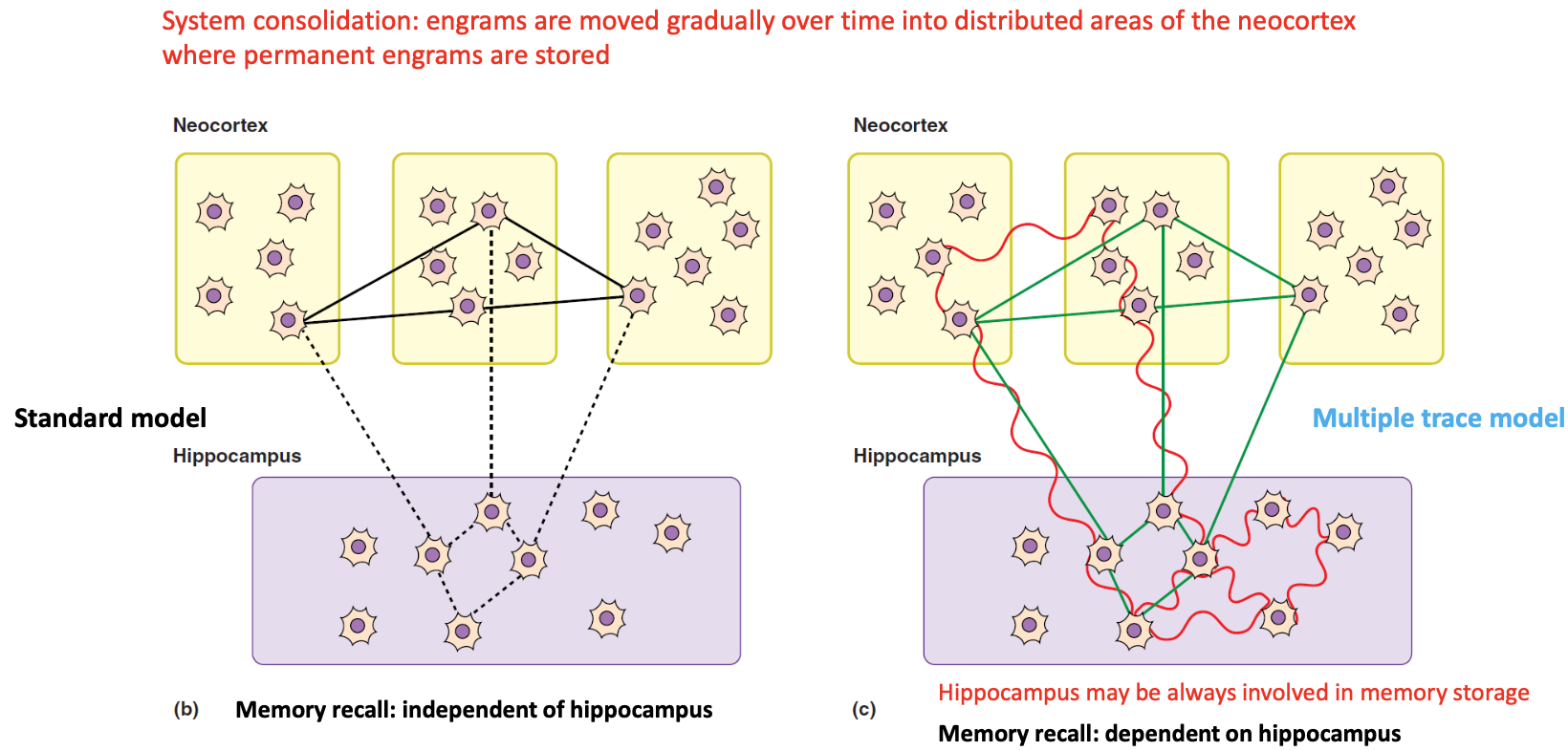
- overlap 가능하고,
이 이론에 따르면, because retrieval requires the hippocampus, complete loss of the hippocampus는 나이 관계없이 retrograde amnesia for all episodic memories를 일으킨다.
partial damage => memories that are intact would be the ones with multiple traces.
To the extent that older memories would have been recalled more times than newer memories, they would be more likely to suvive hippocampal damage, and this would give rise to a temporal gradient in retrograde amnesia.
Conclusion; Experts all disagree. Still unknown.
3.5.2. Reconsolidation.
기억이 없어지는 과정: forgetting, extinction.
기억이 나왔다가 없어졌다가 다시 remote memory로 나타나는 과정: reconsolidation.

이게 분자적으로 consolidation과 매우 유사하게 일어난다고 한다.
어케 되냐하면,
- (2개의) Consolidation으로 Long-term memory가 형성되었다.
- 그 기억을 recall하면 ‘Active Memory’가 된다.
- 이때 engram이 약간 labile(약해)해진다; 강도가 약해지기보다는 외부 자극에 의해 memory가 소실/contaminate될 가능성이 높아진다.
- 그 기억이 다시 long-term memory로 변할 때, reconsolidation 과정이 일어난다.
이 모든 과정은 단백질을 필요로 한다.
이 별표 친 과정은 많이 쓰인다.
심리학 교과서 등에서도 나오는데, 예를 들어 PTSD를 치료하는데 있어서 회상은 가능한 기억을 시키고, 그렇게 memory가 active한 상태에서 긍정적인 자극 등을 줘서 memory의 detail을 바꾸고 훼손하기 위해 간섭한다. 그렇게 될 수 있다.
또 다른 예시로,
- 시험공부 => 3개월 후 까먹음
- partial queue를 통해 Recall될 수 있음.
- 그렇게 active되면 별다른 일이 없으면 기억이 그 상태로 되돌아가지만, 이때가 제일 기억이 바뀌기 위험한 시간이 된다.
물론, 교수님은 지식 등은 거의 막 정해져 있는거라(?), 이런 일로 문제를 겪기가 그리 쉽지는 않다고 했다. 그런데 예를 들어, 누가 나에게 내가 오래전에 배웠던 개념을 물어보는데, 내가 그걸 forget했는데, 이거이거 아니에요?하고 틀린 말 하는데 납득이 간다? 그러면 그렇구나 하고 생각하고 틀린 지식이 저장될 수 있겠다.
오늘은 여기까지 했다. 정리하는데 시간이 오래 걸렸지만, 이건 좀 기억해두어야 할 것 같아서 기록해두었다. 앞으로 공부하고, 내가 하고 싶은 일을 가장 많이 할 수 있도록 계획을 짜고 실천하고 복습 순서를 정하는 등의 과정에 사용하면 좋겠다.

.png)